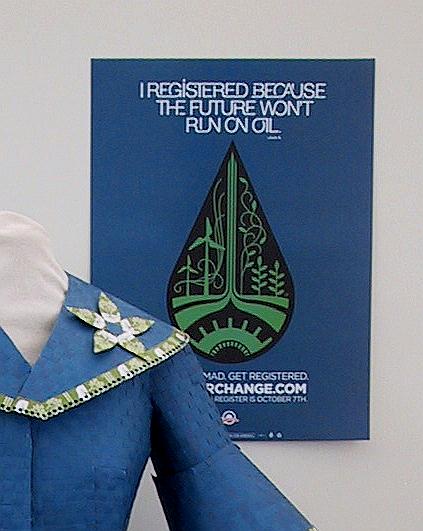Art in Review
April 20, 2012
By Michael Abatemarco
Read original article.
Nancy Judd and Nicole Morris: Consumption, New Mexico Arts Centennial Project Space, 54 ‘6 E. San Francisco St., Suite 2, 699-4914; through May 5
Repurposing found and discarded objects, while not a new concept, is given a considerable new twist in Consumption at New Mexico Arts Centennial Project Space.. The objects in the installation assembled by Nancy Judd and Nicole Morris are arranged to resemble a child’s Western-themed
room, complete with a bed, hobby horse, play kitchen, lamp, story books, mobiles. and other odds and ends. These objects were culled from Santa Fe’s Buckman Road Recycling and Transfer Station. Each item has a price tag, but the twist isn’t what you get for your money. Instead, the “price” is explained in terms of environmental impact of the
materials of which the items are made. It is the price we pay for what we, as consumers, throw away. Chemicals in certam paints, for example, leach into groundwater over time, with potentially deleterious effects on human life and wildlife.
Consumption can hardly be reviewed in terms of its aesthetics, like a traditional art exhibition. All that can be said on that note is something along the lines of the verisimilitude of the room compared with one in which a child would feel at home. At the opening on April 13, several children were engaged in playing with the kitchenette and reading the bedtime stories. To them, the exhibition was an obvious success. Adults are given a lot more to chew on. The purpose, after all, is to reclaim these materials and show how the things we no longer want are often still usable as is. Few of the items in Consumption are repurposed specifically as objects of art. An exception is the rusted sheet of corrugated steel hanging on the wall, intended as a decoration but not, essentially, a child’s plaything.
It must be mentioned that Morris and Judd, whose long-running Recycle Runway project presents couture fashion designs made from trash, had only 15 hours at the transfer station to locate these objects. It is remarkable and also
dismaying that within that short amount of time they were able to pull together enough throw-aways to create the installation. Had they been given more time, a completely different environment would be the result.
For the most part, everything in the show is in good condition. With a little bit of repainting and some cleaning up, Judd and Moms present their room as a comfortable, livable space. It doesn’t look dirty, and it doesn’t look like a room full of trash. Besides, once it is repurposed,, trash can no longer be called trash. The merits of Consumption are in its educational component — the information on the price tags. A lot of us in Santa Fe are concerned about the environmental impact of waste and make an effort to recycle, but we may think of recycling largely in terms of bottles and cans, glass and newspapers. The installation underscores the quality and condition of much of what we throw away and deem undesirable, despite its usefulness. In this sense, Consumption is a real eye-opener.








































